2009 Civil War Travelogue
Welcome to my 2009 travelogue page. Because these pages are starting to become pretty lengthy, I have broken them up into multiple parts.
| Here is a reminder about the reason I write these pages the way I do. They record my experiences and impressions of Civil War trips primarily for my future use. Thus, they sometimes make assumptions about things I already know and focus on insights that I receive. They are not general-purpose descriptions for people unfamiliar with the Civil War, although I do link to various Wikipedia articles throughout. Apologies about the quality of interior photographs—I don't take fancy cameras with big flashes to these events. If you would like to be notified of new travelogues, connect to me via Facebook. |
- CWEA Sarasota Civil War Symposium, January 21-24
- Washington DC Weekend, April 24-27
- UVa Seminar on Petersburg and Appomattox, May 27-31
- Civil War Days at Duncan Mills, CA, July 18-19
- Chambersburg Civil War Seminar on Stonewall Jackson's Valley Campaign, July 22-26
- Abraham Lincoln Bicentennial Exhibit, Sacramento, August 15
- West Coast Civil War Round Table Conference, Clovis, CA, October 23-25 (focus on Chattanooga Campaigns)
- BGES Staff Ride of Franklin, December 2-5
CWEA Sarasota Civil War Symposium, January 21-24
For my first Civil War trip of 2009, I attended the 17th annual Sarasota (Florida) Civil War Symposium, sponsored by the Civil War Education Association. The first question that all of my friends asked was whether there were Civil War battles there. Although there were a few minor battles in Florida, I am certain that Sarasota was selected primarily to lure northern historians from colder climates. The daily sessions were arranged to end by early afternoon, presumably to allow for beach time. Unfortunately this week suffered a cold snap and not many of those historians were seen lounging around the pool. By the last day, it was comfortably in the low 70s. My wife Nancy accompanied me on this trip, although she did not partake in any of the Civil War lectures or social activities. I would estimate that about 150 people attended.
Wednesday, January 21
We arrived at the Tampa Bay airport and drove to the Helmsley Sandcastle Beach Resort on a spit of land called Lido Beach. It was a comfortable, old-fashioned beach motel with a nice pool and a beautiful stretch of beach outside. (Nancy and I did a good deal of driving around and found that virtually all of the beaches in this area are quite beautiful.) The symposium started with a reception and book sale.
Thursday
I was disappointed to learn that James I. "Bud" Robertson was not able to attend, but Ed Bearss agreed to fill in for him. Ed presented Robert E. Lee and J.E.B. Stuart at Gettysburg, which summarized Stuart's activities in the campaign. Ed was at his colorful best and made a number of interesting comments, such as that Wade Hampton was the equal of Nathan Bedford Forrest in strength, and equally willing to kill Yankees. Mules are smarter than horses because a mule will not allow himself to be worked to death. Ed recommended Jeffry Wert's new book about Stuart and said that the description of Stuart's death made his eyes moist.
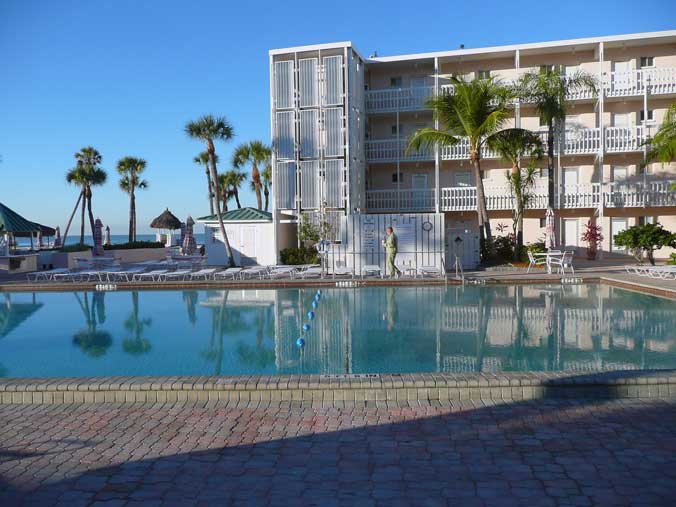 |
Helmsley Sandcastle
|
|
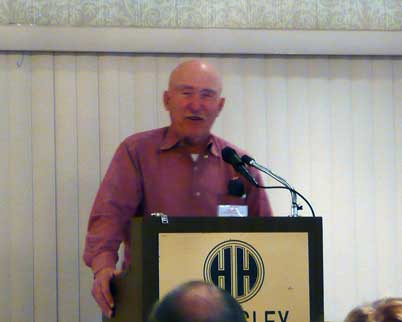 |
Ed Bearss
|
|
Harold Holzer presented on the subject of his new book, Lincoln President-Elect: Abraham Lincoln and the Great Secession Winter, 1860-1861. Harold is an interesting and animated speaker who has written a number of books about Lincoln and is playing a prominent role in the government's Lincoln Bicentennial celebration. Coming two days after President Obama's inauguration, Harold used part of the talk to focus on differences between inaugurations in those two eras. The most fundamental was that in 1861 the inauguration parade was from the White House to the Capitol and the inauguration address preceded taking the oath of office. He made fun of Obama using Mary Todd Lincoln's menu for the inauguration luncheon, joking that Ted Kennedy's seizure may have been caused by that food. He thought that Obama was not being presumptuous by all of his attempted thematic connections to Lincoln, but rather was encouraged by his interest in history. He referred to Doris Goodwin's Team of Rivals and said that she overstated the risk to Lincoln of choosing his cabinet members, since none of them were people who had criticized Lincoln or even debated him as part of the political process (unlike Obama, who chose Clinton and Biden). He said that most scholarship has characterized Lincoln's president-elect interregnum as a time of inaction, but he called this a myth and said Lincoln was actively opposing the attempts at compromising on the slavery issue. (Apparently there is a lot of material in the Lincoln papers that were not made available to the public until 1947 and that many historians have never availed themselves of this source material.) In a discussion of Lincoln's furtive trip from Philadelphia to Washington, he referred to Allan Pinkerton as McClellan's "official exaggerator." He thought that the threats against Lincoln in Maryland were credible, but it was not worth the evasive action that Pinkerton caused Lincoln to take.
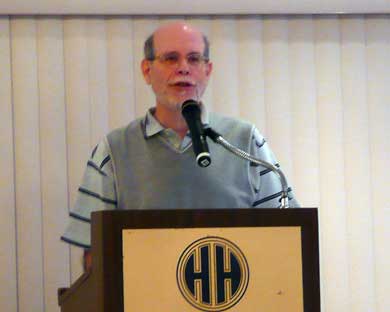 |
Harold Holzer
|
|
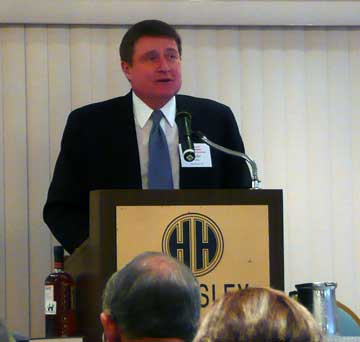 |
Dale Phillips
|
|
Dale K. Phillips presented New Orleans: The Greatest City of the South and Its Capture by Federal Forces. He told an interesting anecdote about modern-day New Orleans children being frightened by their nannies with threats of Gen. Butler coming to get them. New Orleans was the largest city in the Confederate States at the time and no one believed that the Federal attack would come from the south. He described the attacks against Fort St. Philip and Fort Jackson. Fort St. Philip was the site at which the British were repulsed after the 1815 Battle of New Orleans by Jean Lafitte's artillery. He said that one of the prime motivations to capture New Orleans as quickly as they did was to prevent the completion of two giant ironclads, the Mississippi and Louisiana, both 260 feet long, the "[CSS] Virginia on steroids."
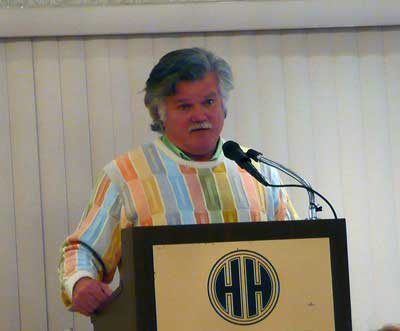 |
Jack Davis
|
|
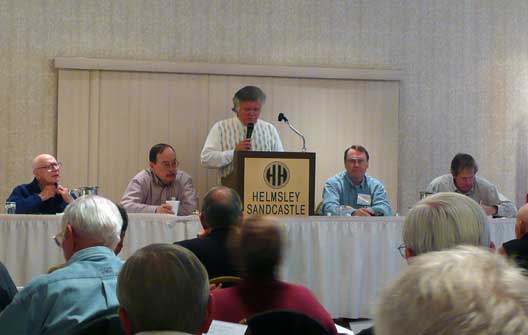 |
Panel on Books |
|
In the afternoon there was a panel discussion, Breaking New Ground -- Books That Opened Doors in Civil War History. Charles P. Roland mentioned being influenced by Randall and Freeman. For current books, I was interested that he singled out Kent Brown's Retreat from Gettysburg (which he said demonstrated that Lee got an enormous logistical benefit out of the Gettysburg Campaign, making the campaign worthwhile in a strategic sense). He also enjoyed Glatthaar's new book about Lee's Army and Dufour's The Night the War Was Lost about New Orleans. Bob Krick gave a rather disappointing explanation of why Broadfoot's Index to Confederate Service Records and the Index of the National Archives were so influential to him. Craig L. Symonds cited the lyrical style of Bruce Catton and, forcing himself to select one title, picked A Stillness at Appomattox. He also referred to T. Harry Williams's Lincoln and His Generals, The Killer Angels, David Potter's Impending Crisis, Benjamin Thomas's biography of Abraham Lincoln, and Tourgee's novel about Reconstruction, A Fool's Errand. Mark Bradley cited John G. Barrett's books on North Carolina. He also said good things about Shelby Foote's Narrative and his novel, Shiloh. (Bob Krick said he would not trust Foote more than a phrase at a time, whatever that means.) Jack Davis described two online sources, ancestry.com and newsbank.com, as invaluable research tools. During the question period, Bob Krick referred to Clifford Dowdey's Lee as "unbalanced" and said that Elizabeth Pryor's recent book of Lee's letters, Reading the Man, contains about 90% material that had already been published previously. Charles Roland referred to a review of one of his books by Clifford Dowdey in which it said that "aside from the interesting foreword provided by the publisher, it was a pedestrian rehash of stale sources." Whoa.
There was a poolside reception scheduled at 5 PM, but it was rather cold for that and they moved it inside.
Friday
After a stimulating day of interesting presentations on Thursday, Friday took a new course.
Charles P. Roland read a paper on Some Bluegrass Confederates, which was essentially two brief biographies of Albert Sidney Johnston and John Bell Hood (the latter of which was born in Kentucky, although his service is usually associated with Texas). He gave a defense of Johnston's leadership at the front during the Battle of Shiloh, citing great generals such as Rommel and Wellington who were supposedly successful because of that trait.
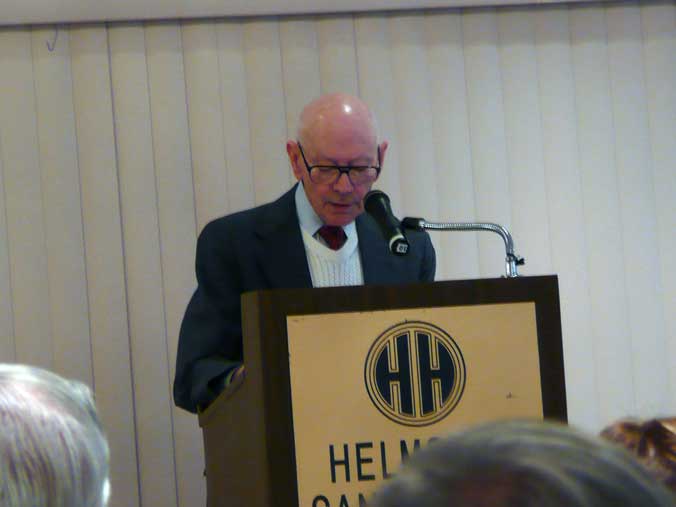 |
Charles Roland
|
|
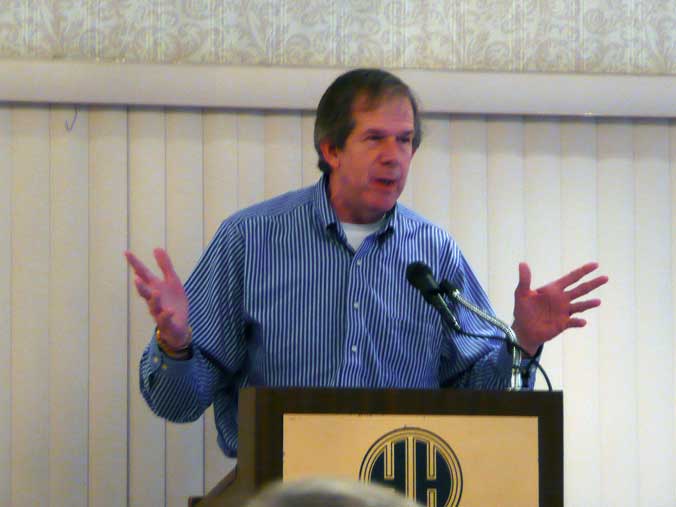 |
Mark Bradley |
|
Mark L. Bradley read a paper on The Warrior As Peacemaker: General William Tecumseh Sherman and the Bennett Place Negotiations, although his reading was a good deal more animated. He made an interesting comparison to Machiavelli's advice that it is better to kill the forefathers of people than to seize their property. In the latter case, resentments last for generations.
William C. "Jack" Davis spoke on Lincoln and His Generals. He said that the Union had 583 generals, 47 of whom were political. He asserted that Lincoln never bypassed the seniority process and I talked with him afterwards, pointing out a few deviations from this, such as selecting the more junior George G. Meade over Henry W. Slocum to command the Army of the Potomac before Gettysburg. He said that he disagreed with the major premise of T. Harry Williams, that Lincoln made fundamental changes in the military establishment to win the war. When asked about James McPherson's new book on the same subject, Jack said that he and Jim came to that same conclusion. (If you would like to see a stunningly scathing review of that book, see here.
After lunch, Ed Bearss spoke on the New Mexico Campaign of 1862. Ed has a way of providing lots of specific details that enhance your enjoyment of material you already know, but this is one campaign of which I lack familiarity. (I have never had much interest in anything that happened west of the Mississippi.)
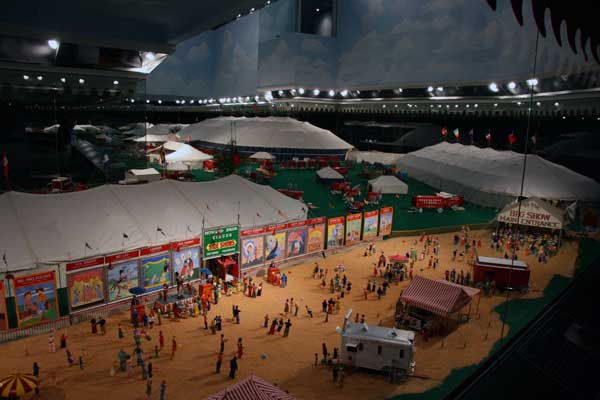 |
Ringling Circus Model |
|
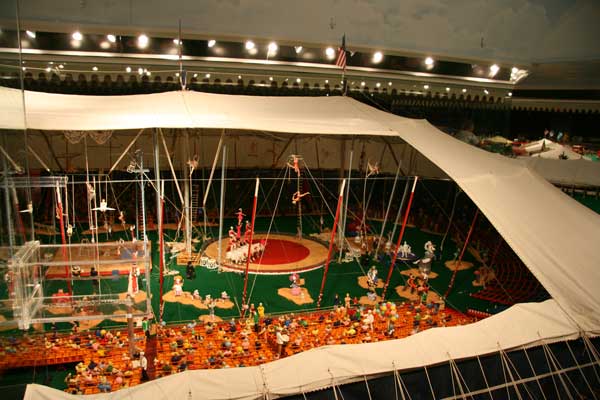 |
Inside the Big Tent |
|
That afternoon, Nancy and I went to the John Ringling Museum in Sarasota and found it very interesting. There is an art museum and a very fancy gilded age mansion on the waterfront, but by far the most interesting thing for me was the scale model of the Ringling Brothers circus. It is over 3800 square feet and the detail is simply astonishing—it took decades to build and it is still not finished. It depicts how about 1300 people swoop into town on a railroad and build almost a small city in a few hours, including an enormous tent that can seat 15,000 spectators. I thought to myself that this was a group of people equivalent to about a Civil War brigade and I got a much better insight into what a supreme logistical accomplishment it was to move and provision those armies. (The Army of the Potomac, for instance, was 70 times larger than that circus.) We went with my old college roommate and his wife and the four of us had dinner at Ophelia's that night, a seafood restaurant that I would recommend.
Saturday
Saturday rebounded with the two most interesting presentations of the week.
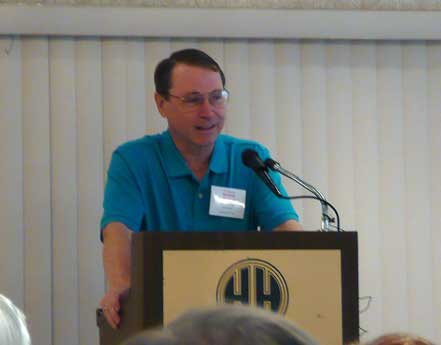 |
Craig L. Symonds
|
|
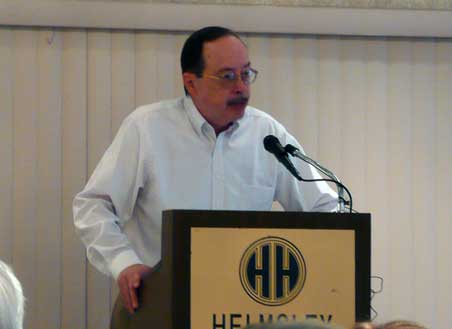 |
Robert K. Krick |
|
Craig L. Symonds gave the third Lincoln presentation of the symposium, Lincoln and His Admirals, based on his new book of that name. Craig is an outstanding speaker and I greatly enjoyed a previous talk he gave in Sacramento about the brown water Navy. He started off by talking about the specific role of the commander-in-chief and pointed out some historical precedents, such as George Washington personally leading the Army against the Whiskey Rebellion, and that Andrew Jackson intended to personally lead the Army against South Carolina in the Nullification Crisis of 1831-32. However, Madison in 1812 and Polk in the Mexican War had no direct military role other than selecting the generals. Craig talked about how Lincoln handled the Trent Affair, and how Lincoln and Treasury Secretary Salmon P. Chase performed personal reconnaissance that led to the surrender of Norfolk. He concluded with a discussion of two admirals and their differences: Samuel Francis Du Pont and David Dixon Porter. Lincoln thought of Du Pont as another McClellan, too cautious. Although he won the first Union victory of the war at Port Royal, he was unsuccessful in attacking Charleston in 1863. After his ironclads were "clobbered" there he planned a gradual series of advances that Lincoln thought were reminiscent of McClellan's siege of Yorktown and he was relieved. Porter was compared to Joseph Hooker, a "busy schemer." As a fan of the Vicksburg Campaign, I always have good things to think about Porter, but Craig cited the way that he stabbed his foster brother, David Farragut, in the back.
Robert K. Krick Spoke on Major General Joseph B. Kershaw: The "very brave man and elegant commander" Who Liked Cigarettes, Garlic Sausages and a Teen-Age Virginia Girl. Bob gave one of his typical humorous, well spoken talks that comprise a thorough biography of one of the only two major generals in Lee's Army that were not West Point graduates (the other being John B. Gordon). Previous speakers had remarked favorably about Bob's use of elaborate vocabulary and he lived up to his reputation. I was most amused by his reading of quotations from the married, middle-aged Kershaw's romantic letters to a teenaged Virginia girl.
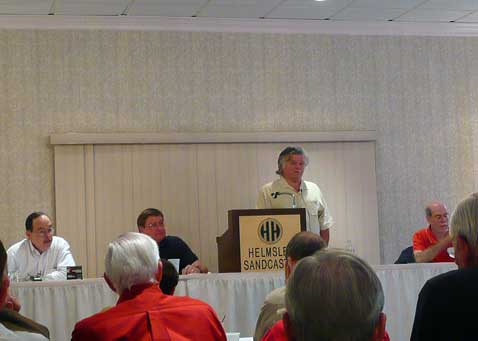 |
Panel on Commemorations
|
|
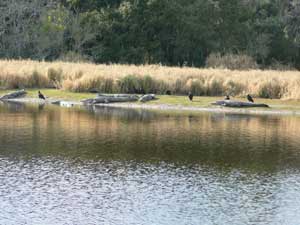 |
Another Panel at Myakka River |
|
The final symposium event was a panel discussion, Civil War Commemorations, Past and Present. Harold gave a lengthy explanation of the Lincoln Bicentennial activities, which are being celebrated actively by the Feds and 45 states. Bob described the activities of the Civil War Centennial, which apparently were driven very strongly by Bud Robertson. Dale talked about how the National Park Service in the Midwest is getting ready for the sesquicentennial of the Civil War (which is really not very much). And Jack talked about the Virginia contributions to the sesquicentennial, which I was disappointed to learn has very little focus on battles, and more on the other activities such as the effects of the war on civilians and agriculture in the state.
Nancy and I spent the rest of the day at Myakka River State Park, looking for alligators. We also watched the sunset at Nokomis Beach—quite spectacular, accompanied by an impromptu gathering of people banging on drums. We flew back Sunday, concluding a very enjoyable and successful joint vacation.
Washington DC Weekend, April 24-27
I had not expected to record a Civil War trip in April, but every year Nancy and I try to go on a long weekend trip for her birthday and this year I convinced her to go to Washington, DC. Although the three-day trip did not focus exclusively on Civil War related activities, it is rather difficult to avoid them in the nation's capital. Although we did things unrelated to the Civil War, I will not bother to say much about them in this report.
This was a relatively inexpensive trip because I used frequent flyer mileage and Priceline.com to get a very good deal (less than half list price) on a hotel that turned out to be the Loew's Madison, located near Thomas Circle, about five blocks north of the White House. The hotel was hosting a conference for an organization of women that seemed to have not started out life as women, if you know what I mean, so there were quite a number of colorful sights in the lobby over the weekend. We also did not rent a car because parking charges in DC are just as outrageous as other large cities nowadays.
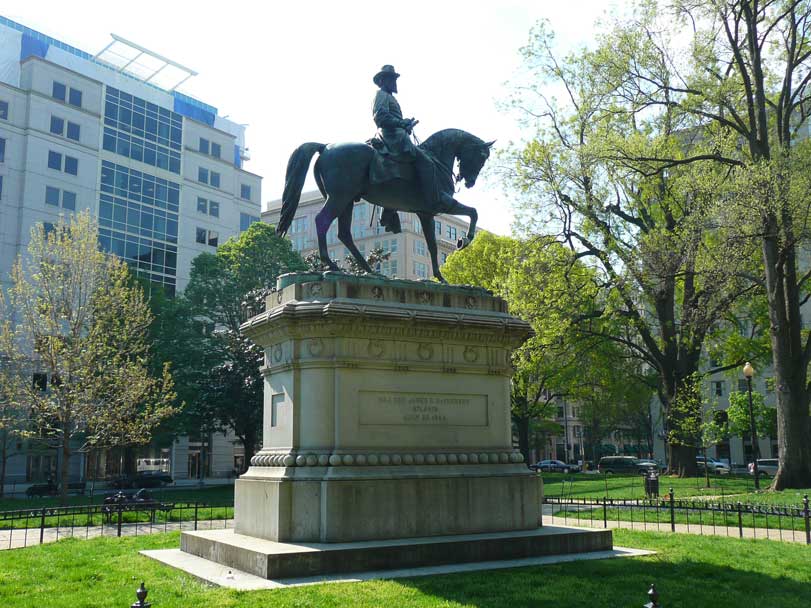 |
Jimmy B at McPherson Square |
|
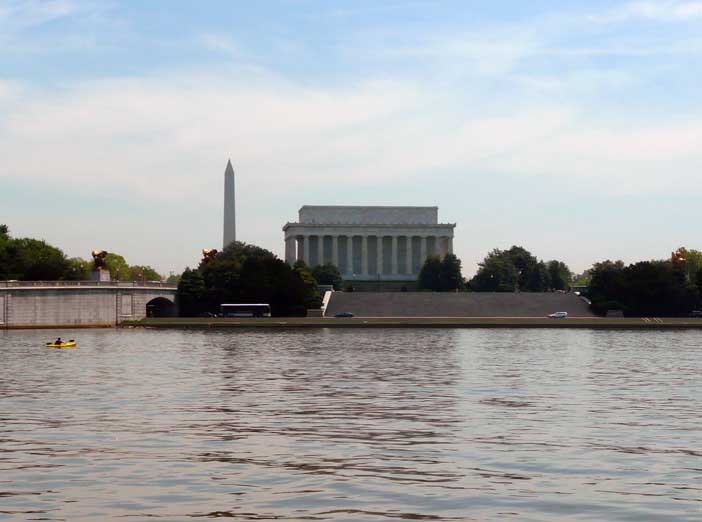 |
Boating on the Potomac River |
|
One of the things I like about DC is how you are always able to trip over Civil War history—statues, streets, circles and squares honoring Civil War heroes. Within easy walking distance of our hotel were Thomas Circle (George Henry Thomas), Dupont Circle (Samuel F. Du Pont), McPherson Square (James B. McPherson—although I am sorry to say it is primarily a park for homeless persons), Scott Circle (Winfield Scott), and Logan Circle (John A. Logan). During our excursions, we also happened upon Sheridan Circle (Philip Sheridan), Sherman Circle (William T. Sherman), and Grant Circle (Ulysses S. Grant). Pretty exciting! Our hotel bellman did not know who George H. Thomas was, even though his equestrian statue was one block from the hotel, but I gave him a quick lesson on the Rock of Chickamauga along with his tip.
We arrived Friday night and had a late dinner at an excellent casual Thai restaurant near the hotel, "Thai Tanic" on 14th St. Saturday morning we indulged in one of Nancy's favorite tourist tactics, which is to buy tickets for a double-decker hop-on hop-off bus, which gives you a good overview of the major attractions and neighborhoods of the city and offers the opportunity to stop off at those that interest you. Part of this ride included a stop that we made in Georgetown for lunch and a boat ride on the Potomac. (Here's a great piece of trivia: the Potomac's water is clean and they harvest 9 million pounds of eel from it every year!) We made another stop at the beautiful Union Station to deal primarily with dehydration issues. Washington was unseasonably hot this weekend and although I do not believe the humidity was at normal high levels, upper 80s and low 90s can really have an effect on you. We attended a free concert of big band jazz at an outdoor theater near the Washington Monument. Dinner was at Ristorante Tosca, which I selected based on a magazine article that said you could do people (politician) watching there, but we saw no one memorable. However, the food was really excellent and I would recommend it.
 |
On Sunday we went to Mount Vernon, which is a transportation ordeal if you don't have a car and don't want to take a packaged tour: 30 minutes on the Metro (which uses tickets adorned by Barack Obama's smiling face, something there is no shortage of in DC), followed by a 30 minute ride on a bus that leaves only once an hour. Once you get there, it is a great experience and it has been noticeably upgraded for tourists since the last time I visited, which must've been 10 years ago. The grounds are beautiful and all of the exhibits are very well done. There are a lot of farm animals and I hope I did not pick up swine flu from any of them.
We headed back on the Metro for my first significant Civil War stop, Lincoln's Cottage at the Armed Forces Retirement Home. Lincoln spent about a quarter of his presidency living at the cottage, which is on a hill 3-4 miles northeast of the White House, because the weather was slightly more tolerable in the hot summer months. The family moved in with minimal household furnishings and Lincoln would typically commute to the White House on a daily basis, escorted by a company of cavalry. He had a number of meetings on political and military topics and quite possibly wrote the Emancipation Proclamation on the premises. We signed up for a one-hour tour conducted by the National Trust for Historic Preservation and I must say that they did a really excellent job. Our small group, all of whom had reservations, watched a brief multimedia presentation in the visitor center and then walked across the street to the cottage. The cottage is like a large suburban house and has been restored nicely. Our tour guide emphasized that the experience is focused more on Lincoln than on the contents of the cottage and it is quite odd to see room after room with only minimal decoration, sometimes only a couple of chairs and a small table in a large room. Most of the rooms had multimedia features, such as large-screen TVs and speaker systems that the tour guide could use to call up illustrations, quotations, and simulated dialogue. The tour covered Lincoln's daily routine, his important decisions, and some of the important and less important visitors. I was very impressed that the tour guide, in a manner similar to Lee's comments about Meade, made "no mistakes on my front." At the end I got an opportunity to pose in front of a life-size statue of Lincoln and a horse.
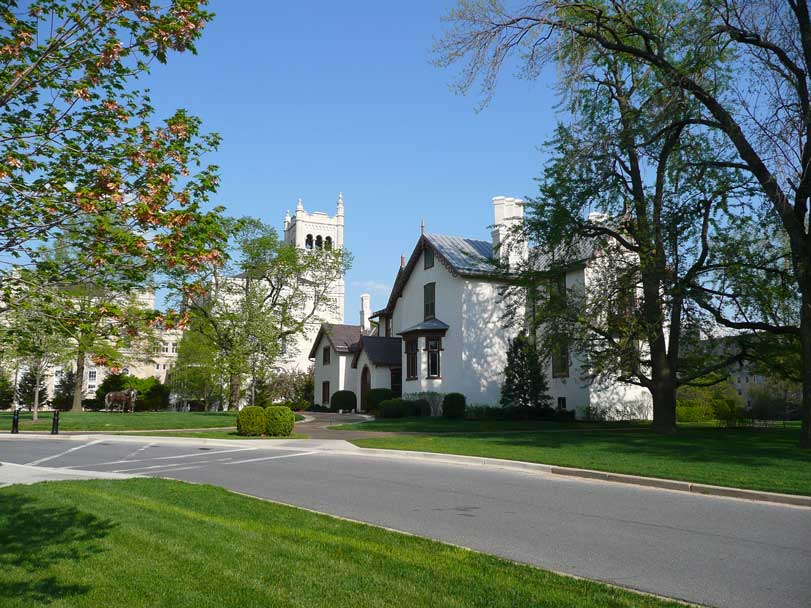 |
Lincoln Cottage, Soldiers' Home in background |
|
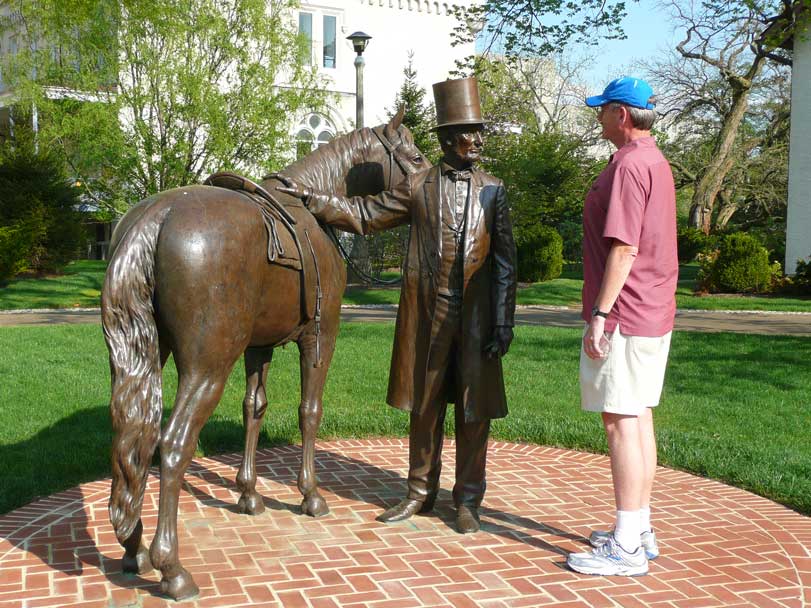 |
He isn't so tall! |
|
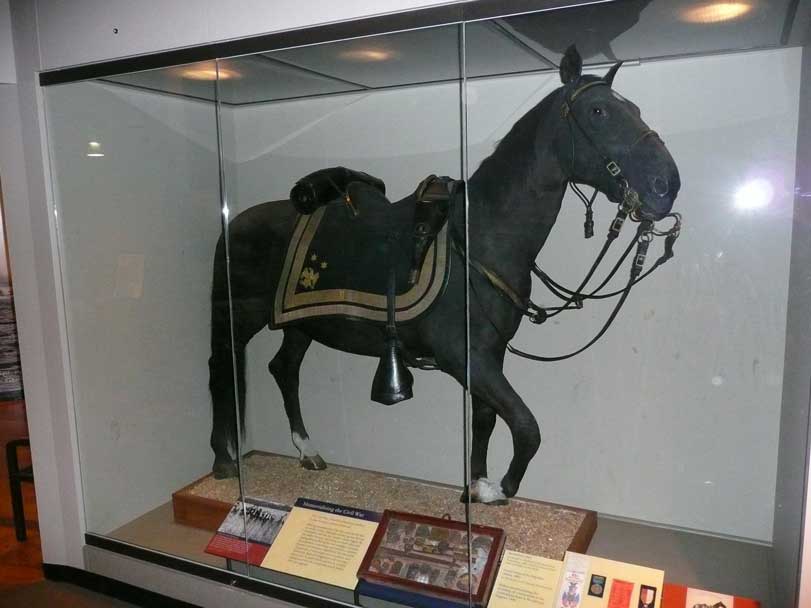 |
Sheridan's Horse Winchester (Rienzi) at the Smithsonian
|
|
Monday was museum day and we started at the newly renovated Smithsonian Museum of American History. The flag from Fort McHenry was very nicely displayed. They have a pretty good, pretty comprehensive exhibition on American military history, which condenses the Civil War down to about a room. I was pleased to see that it was not one of those politically correct exhibitions that concentrates 90% on slavery, gender, and social issues. However, as I imagined, they cannot go into very much military detail. They pretty much ignored the Western Theater other than Vicksburg and Sherman in Georgia. They incorrectly used the expression "Sherman's March" for all of his activities in 1864, starting from Chattanooga, conflating the Atlanta Campaign and the Savannah Campaign. It was amusing to see them say there were no significant battles during the March and to contemplate what the survivors of Kennesaw Mountain or Atlanta would've said about that. The museum also has an interesting exhibition on Lincoln's bicentennial, in addition to its general treatment of the presidency.
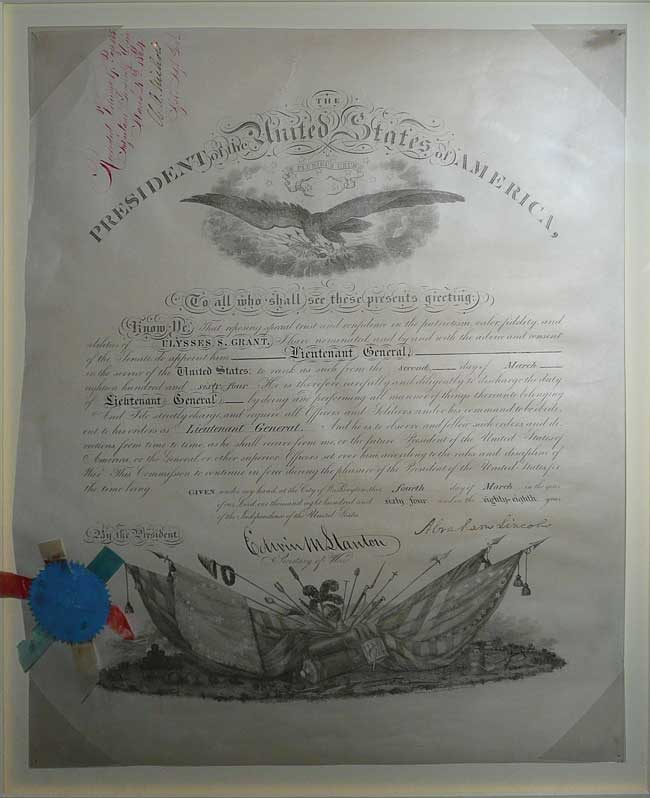 |
Grant's Lt. Gen. Commission |
|
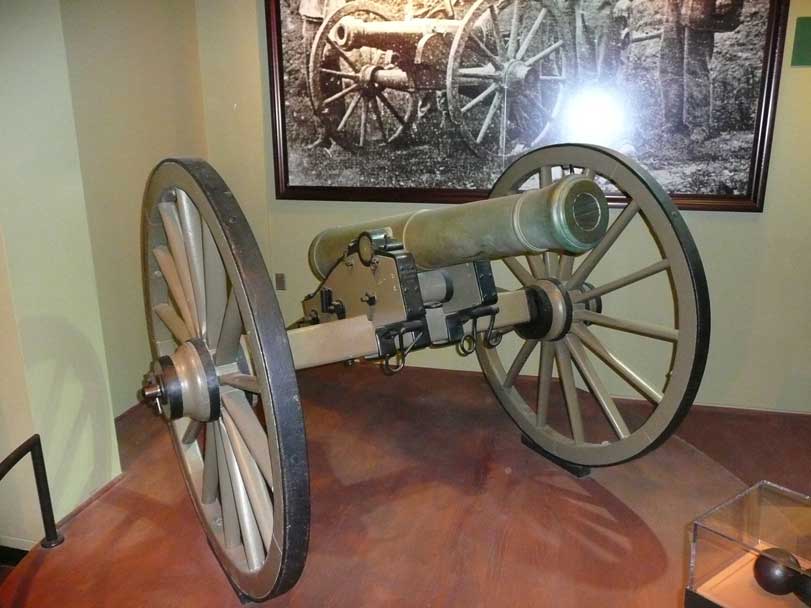 |
M1841 Six-Pounder |
|
We stopped briefly at the Smithsonian's Museum of Natural History and checked out the dinosaurs and mammals, but then went to the National Archives. I lined up for quite a while to see the documents in the rotunda while Nancy took a rest. The most interesting for me was a handwritten proclamation from Andrew Johnson in 1866, declaring the end of the insurrection in 10 of the 11 states. There was a special 75th anniversary exhibition for the archives called "BIG," which had interesting things of large dimensions, such as Shaquille O'Neal's size 22 basketball sneaker, William Howard Taft's bathtub (I wish I had it, believe me, if only I could afford the water bill), and a 13x13-foot edition of the Gouverneur K. Warren map of the Gettysburg battlefield, completed in 1868-69. Oddly, the map was on the floor and separated into a grid of 20 pieces, so it was not so easy to get your bearings.
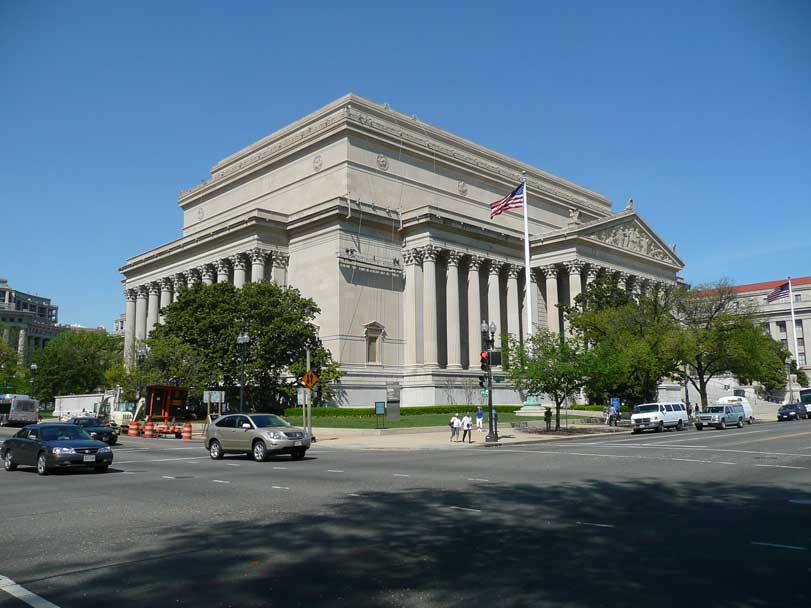 |
National Archives |
|
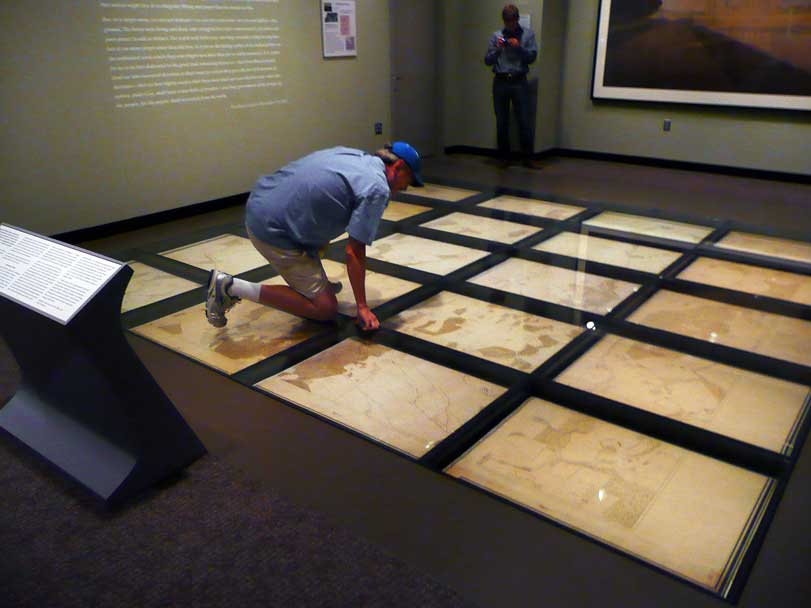 |
Looking for Little Round Top on the 13x13-foot Gettysburg Map |
|
We escaped from the heat by going to an afternoon movie and flew out on a late flight Monday night and returned to San Francisco in the wee hours of Tuesday morning. We had an outstanding time, expertly balancing my Civil War interests with Nancy's levels of tolerance. (She said that she did enjoy the Lincoln Cottage quite a bit.) I did not attempt to go whole hog by visiting places such as Fort Stevens or Ford's Theater, searching out graves at Arlington, or venturing out to Manassas. Maybe someday...
Go to Part 2 of the 2009 Civil War Travelogue page























